| Cheoah
Hemlock climb, March 31, 2006
The Cheoah Hemlock was spotted and named by Rusty Rhea, USFS-NC
Forest
Health Specialist, during an aerial predator beetle release (to
combat
hemlock woolly adelgid) in the surrounding grove in May 2004.
During a
release in a nearby tree, Rusty asked if I had seen the tree
downstream, one
he thought to be a giant standing 160’ tall. When I returned
to the ground I
checked it out. I measured the girth to over 16’, but lacking
a laser was
not able to measure the height. Jess Riddle and I returned
several weeks
later to measure the tree and others in the grove.
Kelsey Tract Old Growth Hemlocks May 2004
Carolina hemlock forest
Kelsey Tract, Highlands, NC
The tree grows in what is known as the Kelsey Tract. It is a 271
acre
protected relic of a vast (1000 acre+) old-growth eastern and
Carolina
hemlock forest near Highlands, NC. Elevation of the tract is
approximately
3800 feet at the lowest portion and goes up to 4260 feet on the
ridge top.
The coves are dominated by incredible ancient eastern hemlock
while the
ridges are dominated by wind “flagged” Carolina hemlock,
eastern white pine
and pitch pine. Dense and oppressive shrub layers exist in both
forest
types, with dog-hobble, rosebay rhododendron and cinnamon
clethra dominating
the eastern hemlock forest and Catawba rhododendron, mountain
laurel, and
blueberries dominating the Carolina hemlock forests. Both
forests contain
very old and gnarly trees of many species, with the oldest known
Carolina
hemlocks found at this site.

Cheoah Hemlock from 2004 - Much greener than
present status |
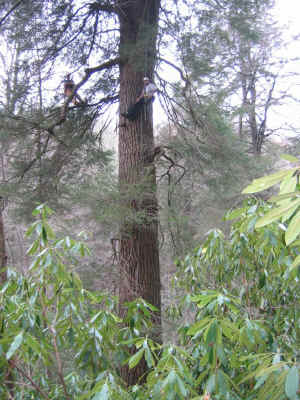
Lower trunk |
Jess and I were able to measure several awesome hemlocks that,
considering
the high elevation, were exceptionally tall and large. One tree,
which is a
respectable 14’2” in girth, was measured to 161’ tall, one
of the few known
in that height class, and the highest topographically located
specimen. In
fact, it is one of only eight hemlocks located outside of the
Smokies that
reaches 160’. The Cheoah Hemlock, which grows at 3850 feet,
was indeed a
tall tree as measured by laser to 157’. With an average crown
spread of 47’
it is a contender for a new National Champion to replace the
fallen tree on
Ramsay Branch, Sevier County, TN-GRSM.

Jason Childs at the base |

Will on initial ascent standing on a huge reiteration |
But most
impressive was the Cheoah tree’s huge canopy, with live limbs
covering fully 65% of the tree. Cascading limbs wound their way
to within 8
feet of the ground. The crown was composed of huge reiterations
that
supported the largest canopy of any eastern hemlock we had ever
seen. The
huge trunk, full canopy and large photosynthetic area suggested
it could be
one of the largest hemlocks ever documented. Thus it was
settled- it needed
to be climbed!
Earlier in
the month Jess and I measured a huge, single-trunked hemlock on
Caldwell Fork, Haywood County, NC-GRSM; a.k.a. the “Caldwell
Colossus”.
After the climb data was analyzed this tree turned out to be the
largest
living hemlock in the Smokies- just ~17 cubes smaller than the
~1402 ft3
Yonaguska Hemlock Michael Davie and I climbed in 1998. The
Caldwell Colossus
had almost the exact dimensions as the Cheoah Hemlock, and
contained 1385
cubic feet of wood. If the Colossus could be so large with a
single trunk
(the Yonaguska Hemlock split into two leads at ~75’), just how
large could
the Cheoah Hemlock be? Caldwell
Colossus Climb Report
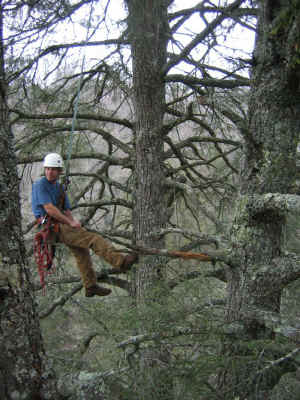
Jason descending the north leader
With the
help of climber Jason Childs and my dad, Carl, we set out to
measure the Cheoah tree. Jason and I climbed the tree while Jess
and my dad
surveyed the (thick!) vegetation surrounding the tree. A
complicating factor
on this tree was the huge crown with multiple leaders and
subordinate
reiterations. The trunks are easy to measure but the fused
sections where
they fork posed a challenge. Wood volume is typically calculated
by
measuring the girth at the “ends” of round trunk sections.
The measured
sections are selected based on changes in the trunk shape or
profile and the
resulting “pieces” added together to calculate the volume of
the entire
tree. The fused sections, however, are anything but round and a
direct girth
measurement over-estimates the area and subsequently the volume
of the
section.

Wood at 80"
Lacking high-tech gadgetry like Dr. Van Pelt, we resorted to a
low-tech but
surprisingly functional system using two six foot poles. In this
case we
used very stiff bean poles from a garden store in a last minute
decision to
try the method. The set-up goes like this:

Setting up the frame to map a fused section
With two climbers on opposite sides of the tree, an area of
fusion is
selected to be measured. The poles are connected by a rope (we
used
non-stretch arborist throw line) threaded through opposite ends
of the poles
so they are adjustable. The poles are temporarily tensioned and
the distance
between the ends measured. Adjustments are made until they are
parallel and
perpendicular to the axis of the trunk. The slight tension
between the poles
holds them steady against the trunk. The climbers sight across
the poles and
agree on a “0” point from which to begin measurements. The
“0” point is the
“point of contact” at one end of the frame when a hard
contractors tape is
stretched across at 90 degrees to the poles. The “0” point
is marked on both
sides as the common reference. This reference is the “0” on
the X axis for
each pole, and the hard tape is used to measure in to the trunk
across the
entire intercept with the pole. Thus, the trunk profile can be
plotted as
the distance from the X axis reference point and the distance in
to the
trunk as the Y axis. Points where the tree contacts the pole is
recorded as
whatever the X distance is and a “0” for the Y. We measured
at changes in
the trunk profile and to the nearest ¼ inch. Graphing of the
data gives a
nice cross section of the fused trunk.

The next
step was to convert the data into area so as to calculate the
equivalent circular area to plug into the volume formula. This
was Bob
Leverett’s job since Jason and I climbed the tree and
collected the data!
Undaunted, he developed a trapezoidal area function in an Excel
spreadsheet
that used the raw data as measured in the field. Dr. Bob Van
Pelt similarly
graphed the data and used the histogram function in Photoshop to
estimate
area. The numbers from each method were 1.67% different.
We were well
on the way to finding out just how large this tree was. First,
a little more detail on the crown measurements. I initially
ascended the
tree and climbed the leader Jess said was the tallest (he was
right by
1.5’). I stretched the tape to the top and then affixed it to
the stem about
9’ from the top. The tape was laid along the trunk all the way
to the ground
and this served as our reference for all subsequent
measurements. Since the
crown was so wide and so many parts had to be measured
individually, I
sketched a map of the tree while Jason was ascending to help
record data and
keep track of things. After this tree, I don’t know how Dr.
Van Pelt keeps
his sanity in those immensely complicated redwoods and the
gnarly trees we
have climbed together like the Sag Branch Tuliptree and the
Middleton Oak! I
am in awe!
Jason hovered by the tape for most of the climb as I sighted
back to it with
a clinometer to monument the heights above ground where I took
the girth
measurements. This was tremendously helpful and sped things up a
lot. Even
so, it took us six hours to map and measure the tree. I never
thought that
two climbers could be so far apart in a hemlock! At times we
were on
adjacent leads 15 or more feet apart.

Trunk confusion- note grafted limbs
For some reason, this tree had an unbelievably complicated crown
dominated
by multiple splits, forks and reiterations. This complex
architecture added
to the climb experience in many ways, not the least of which was
simply
being surrounded by an utterly artistic and strikingly beautiful
tree that
literally engulfed and humbled us. The trunk sections were so
huge and the
canopy so dense it was as if we were climbing in a huge head of
broccoli.
What I found very interesting was the fact that sections of the
canopy was
linked together by branch fusions. For example, a branch from
the main north
leader crossed through the inner canopy, and fused to
subordinate
reiteration #2 on the way to its final fusion into the south
leader.
Subordinate reiteration #3 traveled up the tree from its origin
on the lower
trunk at 71 feet and then fused and disappeared into the north
leader 38
feet higher up. Equally curious was that the four main tops of
the tree were
oriented almost due north south and ascended as follows from
south to north:
151.7’, 155.7’, 156.5’, and 158.0’. These tops were all
vigorous and young
in character, which was surprising since the lower portion of
the tree
looked ancient. I suspect the tree was suppressed for many
years, developed
a gnarly crown, and then was released into the canopy. The
surrounding
forest has very minimal competition on this tree as it is nearly
open-grown
with no adjacent trees of consequence except perhaps on the
eastern side due
to the steep slope.
Ok, back to the volume. The single leader that the tape was set
on scaled
1231 cubic feet, making it one of the largest hemlocks ever
accurately
documented. The multiple tops and reiterations scaled another
333 cubic feet
for a grand total of 1563 cubic feet! This is over 11% larger
than any other
hemlock thus far documented, and as such firmly secures the
title of the
largest eastern hemlock ever accurately documented and claims
the title to
the largest evergreen conifer in the eastern United States (bald
cypress, a
deciduous conifer, is WAY larger than any other eastern
conifer). Eastern
hemlock FAR surpasses the largest known eastern white pines and
loblolly
pines, the only other eastern evergreen conifers capable of
exceeding 1000
cubic feet. Ironically, the largest eastern white pine known may
be a nearby
tree in the Cullusaja Gorge. Jess and I feel it will scale about
1150 cubic
feet and we plan to reticle it soon. Only the Cornplanter Pine
(PA), the Ice
Glen Pine (MA), The Conway Pine (MA) or the Tamworth Pine (NH)
may challenge
the size of the huge pine in the Cullusaja Gorge, also known as
the Zahner
Pine.
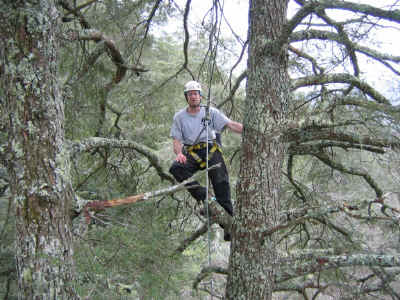
Will on the south leader
Folks, barring the very slim chance of some unknown discovery of
an immense
hemlock elsewhere in the southern Appalachians I feel we have
found the
largest known specimen of its species. Jess Riddle, Michael
Davie and I have
combed much of the Smokies and have never seen a tree that would
rival this
one. There is still a lot of hemlock territory to cover- but it
is at
increasingly higher elevations where, at least in the Smokies,
the species
typically decrease in size. The largest Great Smoky Mountains
National Park
contender we all three agreed on was the Caldwell Colossus,
which is fully
12.1% smaller than the Cheoah Hemlock.
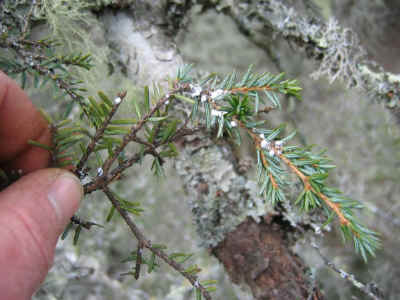
Adelgid from the Caldwell Colossus showing typical
infestation |
Exciting as
this find is, the hemlock woolly adelgid has a firm grip on the
tree despite the tens of thousands of beetles released less than
two years
ago. The entire grove is gray, and all the terminal tips on the
Cheoah Tree
are dead. Obviously, the beetles are not working. Even worse off
is the
Caldwell Colossus, which in my opinion, is almost certainly
dead. Neither
tree will recover to their full glory for many, many years, if
at all. I
firmly feel the Cheoah Hemlock can be saved with insecticidal
intervention,
but so far I have had limited response by officials in the
ranger district.
The Kelsey Tract is extremely significant in that it has huge
and tall trees
for the elevation and has adjacent old-growth examples of both
eastern and
Carolina hemlock forests. The cost of the beetle releases alone
is far more
than the funds needed to treat the entire grove at today’s
chemical cost.
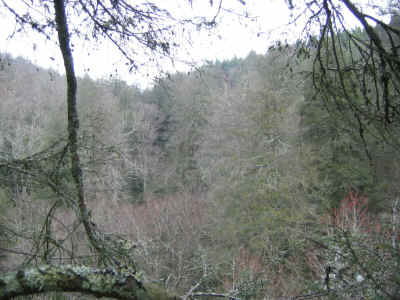
Are the beetles working?
These cost estimates do not include labor, but I for one would
gladly
volunteer to treat several thousand inches. I know there are
others who
would join in this effort, and the task of treatment would not
be
overwhelming at all. I am just afraid it is too late, and this
will be the
fate of many of our exemplary groves. We have already lost the
tallest known
eastern hemlock forest ever documented- the East Fork Grove in
the Chattooga
River watershed in South Carolina. This grove contained six of
the eight
known trees outside of the Smokies over 160’. They were
destined to grow to
exceed the record height of 169’10” within five years, but
the sucking
bastards got to them first.
Will
|